it's possible — how we can create a fairer, greener Australia beyond COVID
- Written by Janet McCalman, Redmond Barry Distinguished Professor, University of Melbourne
We are living through the greatest disruption of the postwar era; what is likely to be the defining historical period of our lives. And the disrupter is a piece of RNA surrounded by fat, a virus human beings have never before encountered.
A virus that ticks all the boxes for disaster: it is novel, it is highly contagious, it is transmitted by asymptomatic carriers, and it attacks and kills people whose immune systems have been undermined by disease, inequality, malnutrition, stress and age.
It’s only months since we were overwhelmed with the bushfire disaster. The climate emergency was upon us more viscerally than ever before. Sydney lost its summer to choking smoke; the glorious forests of the Great Dividing Range and eastern sea- board burnt with an unstoppable ferocity. Lives were lost, as were homes, businesses, communities, and a billion native animals. The koalas screaming in agony were heard around the world. This was our global future burning before our eyes.
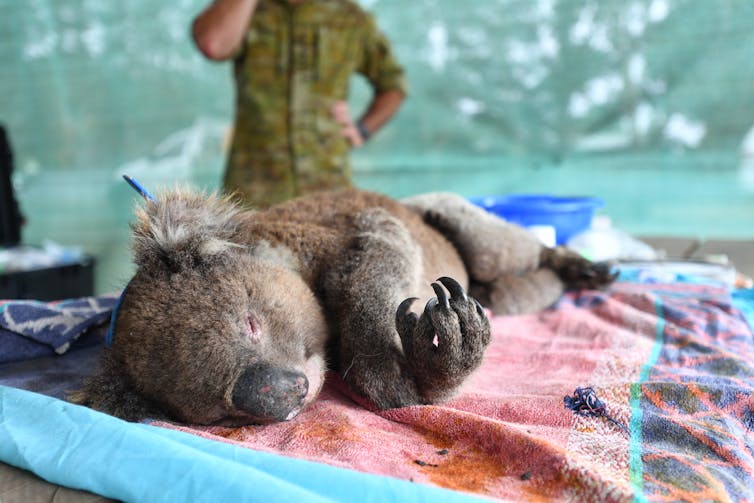 A koala rescued from the Kangaroo Island fires in January.
David Mariuz/AAP
A koala rescued from the Kangaroo Island fires in January.
David Mariuz/AAP
Then came this virus. And it has shut down much of the world by freezing markets and informal economies that daily feed and service most of the people of the planet. But we should understand the virus as an ecological disaster, just like the climate emergency. They are not causally related. Rather, they are expressions of the same profound overburdening of the planet by anthropogenic excess.
Read more: Coronavirus is a wake-up call: our war with the environment is leading to pandemics
The climate emergency has not abated with the pandemic. Extreme weather is everywhere on the planet. Syria is gripped by its worst drought in 900 years. Locusts are swarming over East Africa. We are warned the climatic sweet spot of the Holocene that has made complex societies possible for the last 6,000 years is coming to an end, to be replaced by unbearable heat in some of the world’s most populous places.
Not only the year of COVID, 2020 will be the year, according to the World Food Programme, of the greatest food shortages since 1945. And the global economic collapse, if we are not both brave and careful, will morph into a depression longer and deeper than that of the 1930s.
This is the end of the “good times” for the world, but it has been a long time coming. COVID-19 is simply an accelerant. Therefore, it is important now to focus on what has to be done, for all that stands between us and disaster is good government.
Many young people feel deeply pessimistic about the future. They have little confidence organised society can face profound threats, survive them and rebuild. But the world has done so, even within living memory with the astonishing recovery in Europe and Asia after World War II.
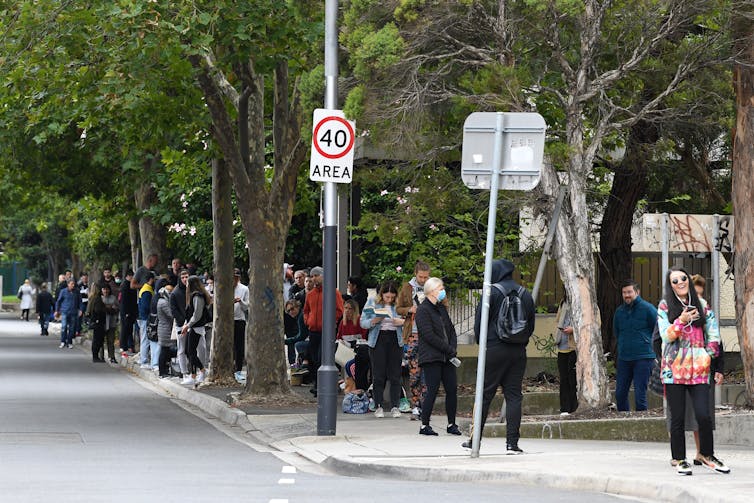 People wait in line at the Prahran Centrelink office in Melbourne in March. Many young people are pessimistic about the future.
James Ross/AAP
People wait in line at the Prahran Centrelink office in Melbourne in March. Many young people are pessimistic about the future.
James Ross/AAP
Critical moral decisions
In 1945, Europe lay in ruins. Eighty-five million people had perished, most of them civilians, deliberately murdered by starvation or industrial slaughter or burnt alive in their torched villages or fire-bombed cities. Sixty million people were displaced and took to the roads.
The total of lost or orphaned children has never been tallied. The 1944–45 winter had been terrible, crops had not been planted and there was no food. In Berlin, only the Russians seemed to know how to ration food and rebuild civil society: the other Allies were at a loss.
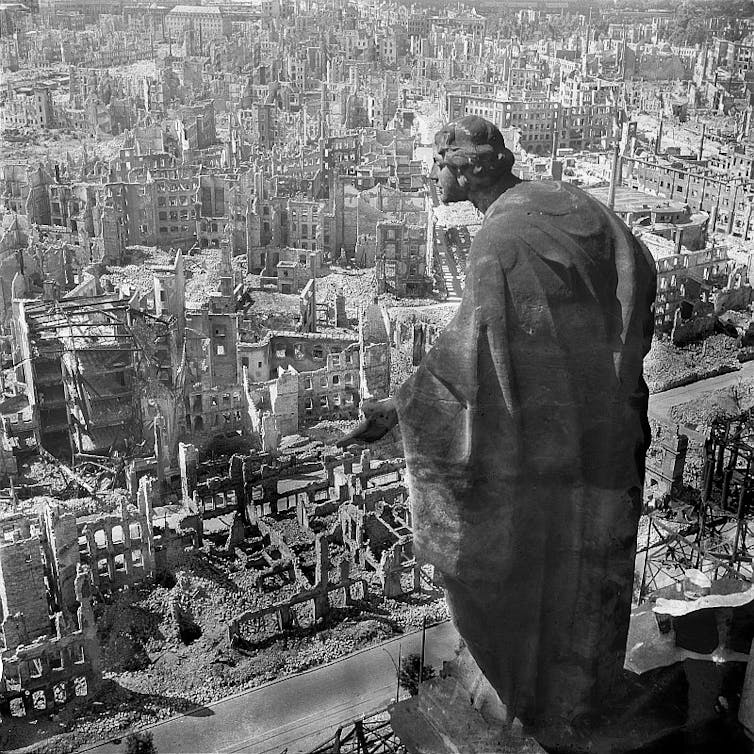 The view from the town hall over the destroyed city of Dresden in 1945.
Wikimedia Commons
The view from the town hall over the destroyed city of Dresden in 1945.
Wikimedia Commons
Civil society had been destroyed by oppression, cruelty and hunger. Scarcely any civilian who survived occupation ended the war with a clear conscience. People had to kill, steal, lie, inform on neighbours, refuse to help when asked, fail to fight when needed. And at the end, they had nothing. They amounted to millions upon millions of destitute, damaged people. A friend’s mother who spent the war in Trieste once admitted that there was no human depravity she had not witnessed.
Not only had the physical world been consumed by fire, so also had institutions, communities and infrastructure. Yet out of the carnage, modern Europe and the Soviet Union rebuilt their cities and homes and their civil societies. If the European Union and the former Eastern Bloc have problems now, their flourishing since 1945 has been a miracle. All have experienced a dramatic improvement in living standards in the past three-quarters of a century.
When this pandemic crisis ends, things will be very bad for those with weak, corrupt and incompetent governments. For those with good governments, critical moral decisions will be required: do we reinvest and rebuild positively, or do we inflict austerity to pay down the debt quickly?
The deaths will be proportionately fewer than in World War II, the buildings won’t be smashed, nor the sewers, water pipes and gas pipes shattered. Physically the world will still be there. Farms will still be producing food except where severe weather has destroyed crops. The shock and grief will be awful, and it will be the world’s turning point between collapse or recovery towards a new resilience.
JM Keynes’ 1940 book How to Pay for the War outlined a program of rationing, war bonds and currency creation that could produce the necessary funds without generating inflation. But the minute the second world war ended, 42% of the British workforce was made redundant.
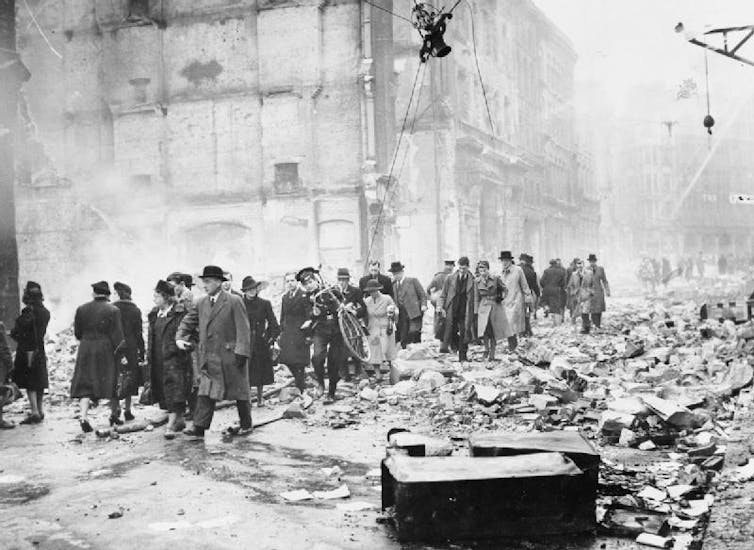 Office workers make their way to work through debris after a heavy air raid over London during the second world war.
Imperial War Museum
Office workers make their way to work through debris after a heavy air raid over London during the second world war.
Imperial War Museum
How did the Allies pay for the peace without a return to the misery and chaos that were experienced after World War I? Rationing and austerity continued, but governments did not stop spending. The new British Labour government passed legislation mandating full employment; the existing Labor government in Australia in May 1945, issued its famous white paper, written by Dr HC Coombs titled Full Employment in Australia. We pre-empted the British, but we were of like mind.
Australia, by comparison, got off lightly from World War II. And Australia also had arguably the best government in its history under prime ministers Curtin and Chifley. They believed in the social contract that government was there to serve the people; that our Commonwealth was formed for the “common good”. They were great internationalists. They prosecuted the war, but they also committed from 1943 to building a better Australia for the people who had sacrificed so much to win it.
Their postwar reconstruction scheme, in just four years of war and four years of peace, established a welfare state and addressed historic injustices to Indigenous people who came under Commonwealth laws. They legislated to mandate full employment after the war, despite the demobilisation of the military and of war industries — and it worked.
Read more: Australia's post-war recovery program provides clues as to how to get out of this
They reformed the economy from the factory to the farm: General Motors-Holden, the Snowy Mountains Scheme and, this time, soldier settlements that were better planned and more successful. They invested in national and international air travel. They trained hundreds of thousands of unskilled workers to be skilled workers, and sent ex-service people to university. They opened Australia to non- British migration, changing us forever.
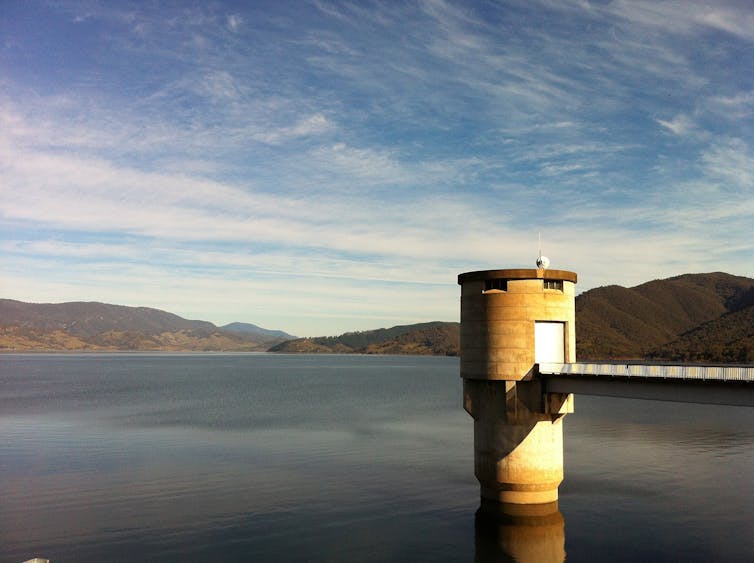 Blowering Reservoir from Blowering Dam, part of the massive Snowy Mountains Scheme constructed between 1949 and 1974.
Wikimedia Commons
Blowering Reservoir from Blowering Dam, part of the massive Snowy Mountains Scheme constructed between 1949 and 1974.
Wikimedia Commons
They lost office before they could implement Professor Sam Wadham’s massive Rural Reconstruction Scheme. But they also believed that the future depended on education and research, establishing our first research university, the Australian National University, to be a Princeton in the Pacific.
They inaugurated Commonwealth Scholarships and research funding. Our first PhDs began to graduate, and our academic gaze turned away from Oxbridge towards our Asian neighbours for the first time. They invested in the CSIRO. Another term of office may have delivered a national health service. We had to wait almost another 40 years for Medicare, but the four years after the war set up modern Australia.
A new accord?
This story is important to retell because it gives us hope — and a model. We need national reconstruction again: to transition to renewable energy, to restore fairness and security to our economy, to rebuild our rural and regional sectors that are beset by poverty, environmental stress and long-time marginalisation.
Climate change imperils our food security as it does our natural environment and wildlife. If we are to reconstruct Australia as a sustainable economy and society, then perhaps 60% of that effort needs to be in the bush.
National reconstruction requires political will, and political will needs a measure of bipartisan support to be effective. Menzies followed the social democratic Labor lead — social housing, support for universities, infrastructure construction. In the 1980s, the Prices and Incomes Accord was struck between unions and employers under the leadership of the Hawke Government. The accord lost its way after time, but initially it did bring down unemployment and inflation, in return for Medicare and new social transfers.
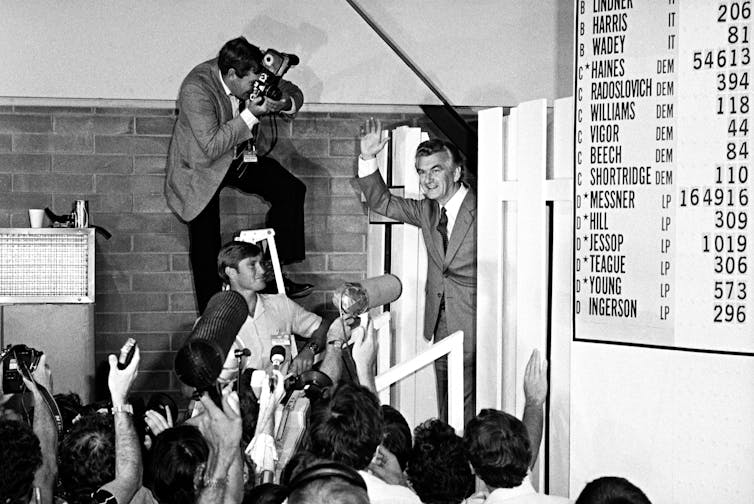 Bob Hawke, pictured here on election night in March 1983: his government struck a prices and incomes accord between unions and employers.
National Archives of Australia
Bob Hawke, pictured here on election night in March 1983: his government struck a prices and incomes accord between unions and employers.
National Archives of Australia
A new accord would be a different social contract. It would require a summit as before, after consultation and planning. It could be led by First Nations people with a mission to heal the nation and the land, starting with the Uluru Statement from the Heart.
Read more: The Uluru statement is not a vague idea of 'being heard' but deliberate structural reform
This time its participants would be drawn from across the spectrum: farmers, business big and small, unions, universities and research, state and local government, the health and welfare sectors, culture and the arts. (Universities have played a vital role in changing course for this country in times of crisis and will do so again, just as their researchers, along with the CSIRO, are leading the fight against COVID-19.)
The accord itself could be a commitment to the guiding principles of the United Nations Sustainable Development Goals, which connect social and economic justice to environmental justice.
This new accord would be a commitment to principles of practice that open doors to funding, tax incentives, advice and collaboration among sectors to build a new sustainable economy, turning Australia into the renewable energy powerhouse that the distinguished economist Professor Ross Garnaut envisages.
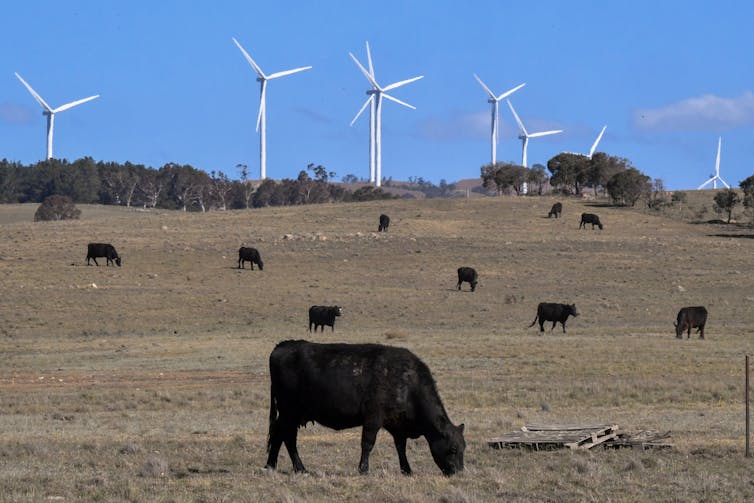 A wind farm near Bungendore, 40km east of Canberra.
Mick Tsikas/AAP
A wind farm near Bungendore, 40km east of Canberra.
Mick Tsikas/AAP
There would be no compulsion for businesses to sign on, but if they chose to be outside the tent, then they would not receive any benefits and opportunities.
Read more: After COVID, we'll need a rethink to repair Australia's housing system and the economy
Likewise, government’s role is not to take the lead on every issue — it can’t, because it doesn’t have expertise to match that already in the community. Rather, it is to ensure that law and order prevail, that there is no corruption or favouritism. We have forgotten the power of the law to bring about social as well as judicial justice.
No nation can truly flourish if its hinterland is degraded and unproductive. Global warming threatens our food security, our pastoralists and, as we saw in the summer of 2019–20, our forests and native wildlife. National reconstruction needs not merely to be bipartisan at the top: it must offer genuine participation in decision-making in how to transition to new industries and farming technologies.
 Joeys rescued from the summer bushfires. Global warming threatens our native wildlife.
RSPCA
Joeys rescued from the summer bushfires. Global warming threatens our native wildlife.
RSPCA
We may need to start growing some crops under cover in highly controlled environments with careful water use and no pesticides. If the Netherlands can become the world’s second-largest food exporter after the United States, then we, too, in a more environmentally sensitive way than the Dutch, can build a high-tech food exporting industry that could replace coal and help feed a hungry world.
To do all this, we need a partnership between farmers, the private sector, workers, government and universities. If employers are to receive funding and research support from the public sector, then as their part of the accord they should commit to providing secure jobs and vocational training. They must be prepared to negotiate improving wages and support more generous welfare provision.
Above all, they need to endorse a government-funded Jobs Guarantee to get people back into the workforce with dignity and security: that is, real jobs with award wages, not work for the dole. The economy will not ‘bounce back’ if no one has money in their pocket.
It is to be hoped that the pandemic will bring an end to the distrust of science and learning that neo-liberalism has spread like poison through the rich world.
It will be time to rethink the tertiary and vocational sectors and fund research infrastructure in universities, alongside restoring the CSIRO and providing more job security for researchers. Our universities could then return to being servants of the public rather than fragile, semi-private corporations.
Read more: As universities face losing 1 in 10 staff, COVID-driven cuts create 4 key risks
All this is fiscally possible if we accept that we can only pay back the debt by economic growth. Artificially balancing the budget via austerity leads to further impoverishment; investing in people and their enterprises to get on with it restores prosperity so that we can grow our way out of debt.
A fresh narrative
Government cannot do it all. Business is the larger part of society, and reconstruction cannot be done without their cooperative engagement, expertise, creativity and resources. But what is possible with the new accord is not a series of precise prescriptions for reform, but rather a narrative that can capture the trust and enthusiasm of an electorate that is disenchanted with politics and politicians.
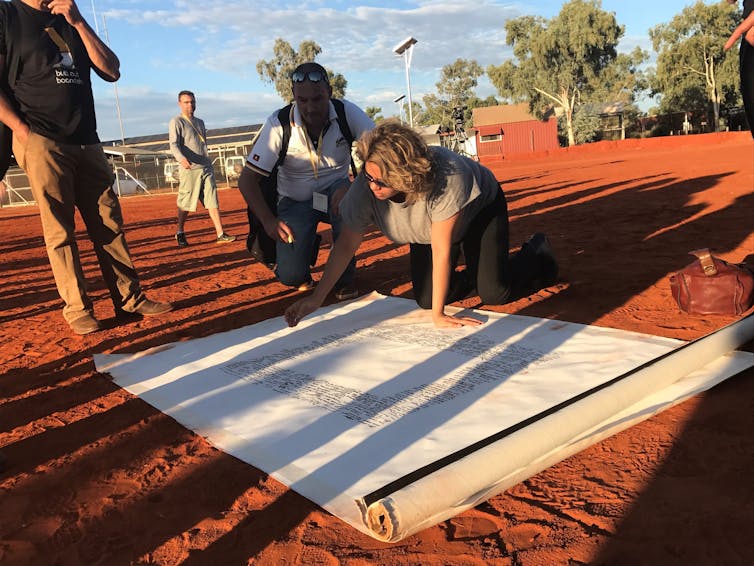 Denise Bowden, Yothu Yindi CEO, signing the Uluru Statement from the Heart, in Central Australia in 2017. A new accord could be led by First Nations people with a mission to heal the nation and the land.
Australian Human Rights Commission/flickr
Denise Bowden, Yothu Yindi CEO, signing the Uluru Statement from the Heart, in Central Australia in 2017. A new accord could be led by First Nations people with a mission to heal the nation and the land.
Australian Human Rights Commission/flickr
People want our leaders to “come together”. The “Green New Deal” is an American idea; the United Kingdom wants a “green industrial revolution”; but we in Australia know how to strike accords and build institutionalised fairness.
Perhaps it does not matter what we call it: perhaps First Nations people will one day permit us to use their term Makarrata to express a new national social compact. We need to reconstruct Australia, better than we have before, and we need to do it for our very survival.
No one—no politician, no scientist, no economist, no bureaucrat, no business leader, no farmer, no pundit and no political party — has all the answers. But collectively we do, provided we can devolve consultation and much decision-making to the communities and regions directly affected. That will build resilience and draw on the experience and knowledge of those who are experts in their own worlds.
The great power of the human mind is that it can work with other minds: our greatest strength lies in each other.
This is an edited extract from What Happens Next? edited by Emma Dawson and Prof Janet McCalman AC, published by Melbourne University Publishing.
Authors: Janet McCalman, Redmond Barry Distinguished Professor, University of Melbourne





